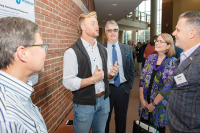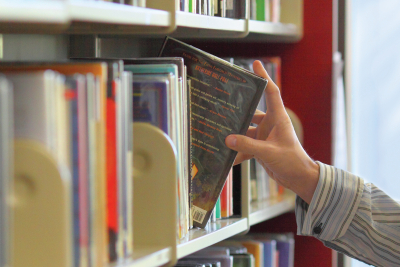Carden in the rye: WNC storyteller bridges past, present
There is no middle ground.
With Jackson County storyteller/playwright Gary Carden, you either love the guy or you tolerate him, a curmudgeon some might say. Luckily, most folks in Western North Carolina appreciate and revel in the singular, beloved personality that is Carden — an increasingly rare voice that serves as a vital window into the past.
Get busy living, or get busy dying
During the 1970s, my dad spent some time in prison. For over three years, he taught GED prep classes at the old Craggy Prison that still stands barricaded on Riverside Drive in Asheville. I’ve always known he taught inmates, but only recently have I become intrigued about this time in his life.
Something about losing my mom at a relatively young age has made me latch onto everything my dad says. Both my mom and dad lived tragically enchanting lives worthy of movie plots. I know bits and pieces of their many stories, but not enough.
Formed by the mountains: Cherokee elder reflects on 93 years of service to tribe and country
The Cherokee of Jerry Wolfe’s early memory is a different place than the Qualla Boundary of today.
Wolfe, 93, remembers hills covered in farmland rather than forest, cleared by hand to keep the trees from encroaching on slopes families coaxed to yield the corn, beans and potatoes that fueled them. The weedy edges of fields yielded blueberries, blackberries and strawberries. The woods yielded fuel for winter heat in the log cabins and, when the family ran out of kerosene, knots of pine sap that could ignite to keep the lights on.
Tell it from the mountain
 There’s only one thing Tim Hall isn’t sure of.
There’s only one thing Tim Hall isn’t sure of.
“Well, I don’t really know my age, but if I had to guess, I’d say I’m somewhere around 70 years old,” he chuckled.
Sitting in The Storytelling Center of the Southern Appalachians in downtown Bryson City, Hall reminisces about his childhood in the mountains of northern Pennsylvania. He grew up in a poor family, like many others in that time and place, but that never deterred them from enjoying life, from sharing in its grace and beauty — sharing in storytelling and oral traditions.
Tell it from the mountain
 It all started with a drum solo.
It all started with a drum solo.
“My mother was of the big band generation, and she’d watch all of these movies when I was a kid with big bands in them,” said Michael Reno Harrell. “I remember seeing Gene Krupa do a drum solo and I decided that’s what I wanted to do.”
Stand and deliver Donald Davis weaned on mountain storytelling
 It’s been said that people are more afraid of public speaking than they are of death, but for Donald Davis, he couldn’t imagine doing anything else.
It’s been said that people are more afraid of public speaking than they are of death, but for Donald Davis, he couldn’t imagine doing anything else.
Former FBI agent shares exploits with students
Traveling around the world, taking down bad guys and helping exonerate the wrongly accused, Steve Moore’s life sounds glamorous — and he will agree that he has loved every minute.
The specter of specters awaits on Bryson City’s Ghost Walk
 By Peggy Manning • Correspondent
By Peggy Manning • Correspondent
Tim Hall relishes in the history and folklore of the mountains but also knows when a little embellishing is in order — especially when it comes to ghost stories.
Shortage of dollars threatens to kill popular local show, ‘The Liar’s Bench’
There’s a meeting this week to determine the future of “The Liar’s Bench.” This is a two-year-old throwback of sorts to the old-timey variety show, a gathering of local talent for the enjoyment, amusement and, on occasion, the edification of audiences.
The Liar’s Bench showcases authentic Southern Appalachian culture. None of your hee-haw tricks are found and exploited on this stage. Just good music, interesting and funny stories, and dramatic renderings of life as it really once was, and often is today, here in the mountains of Western North Carolina.
Lack of money, however, that too-frequent destroyer of art, music, literature and dreams, is threatening to bring The Liar’s Bench to an end. Performances featuring some of the region’s best entertainers will continue through March and maybe into April at the Mountain Heritage Center on the campus of Western Carolina University and elsewhere in the region.
But after that? Well, the situation isn’t pretty.
“Finances might kill The Liar’s Bench,” founder Gary Carden said. “It has to be able to sustain itself. I’ve depended on the good will of people — really, taken advantage of them — for far too long. We hope we’ll do this again, but it’s not certain. Our future is none too secure.”
A show from The Liar’s Bench this past October was featured on the syndicated television program “Life in the Carolinas.” That’s hitting the big-time for any local talent venue. But, no matter how gratifying to those involved, even Carolinas-wide recognition doesn’t pay the bills.
Carden said the musicians and other performers need compensation to, in turn, sustain themselves and their families financially. He remains hopeful that a plan can be formulated to accomplish both those goals: saving The Liar’s Bench and paying the performers. But exactly what form that plan might take, and who precisely will develop this save-the-day plan, remain unsolved mysteries.
Crowd shrinks with ticket sales
The stage at the Mountain Heritage Center is small and intimate. The performance hall seems a perfect venue for this type of show, which generally features one entertainer at a time. The acoustics are good, the lighting well placed, the performers nicely rehearsed.
A couple of regulars for The Liar’s Bench weren’t here on this night, poet and musician Barbara Duncan and musician Eric Young. But Carden, Cherokee storyteller Lloyd Arneach, claw-hammer guitar specialist Paul Iarussi and vocalist/musician William Ritter (the “boy genius” as Carden dubs this exceptional talent) were ready to take the stage. So were guitarist and singer Ken Beck, vocalist/musician Karen Barnes and dramatic monologist Tom Dewees, who would perform Carden’s dramatic work, “Coy.”
On this night, un-typically, admission of $10 per person was collected at the door as part of an attempt to try to stem the tide of financial insolvency. Admission was charged at a show earlier in February, too. Usually the show is free; the crowd tonight was considerably smaller than usual.
Carden, as ringmaster, was nattily attired in a white dress shirt and black pants and black vest. This was Carden in his native element, in full throat and happily on stage even when down in the audience hugging those he knew and shaking hands with those he didn’t.
Carden said he originally conceived of The Liar’s Bench as an opportunity to tell stories.
SEE ALSO: Sylva’s Gary Carden a true Southern Appalachian original
“When local musicians and poets agreed to perform, I realized that perhaps The Liar’s Bench was an opportunity to do more than merely entertain the audience,” he said. “Gradually, the show has become a means of showcasing Appalachian culture and presenting it with integrity and authenticity.”
If the show goes under another project now in the works could be lost, too: The Liar’s Bench and the Mountain Heritage Center have been developing a series of programs called “The Balsam Chronicles.” The project is based on the history and folklore of the region.
A future training venue
Arneach is one of the most notable performers participating in The Liar’s Bench. On this night he told two stories, one Cherokee in origin and the other about a veteran of military service. Arneach is an enrolled member of the Eastern Band of Cherokee Indians and he served in the Vietnam War.
A tall, barrel-chested man, Arneach quickly captivated the audience with his booming, yet seductive, storytelling voice. His stories are relatively short, maybe 10 minutes in length tops, with defined beginnings, middles and ends. The applause when he finished was sustained and appreciative.
Arneach, in turn, is grateful to this venue and the additional people it allows him and the other entertainers involved to reach. He said that the growth of The Liar’s Bench in popularity over the past two years has been phenomenal to participate in and to watch.
“To get to see this type of diverse talent in one setting is unique to this area,” Arneach said.
He recalled the early shows at City Lights Bookstore in Sylva. The Liar’s Bench rapidly outgrew the small room available there and moved through other venues before landing in its current home here at the Mountain Heritage Center. Until this month and the two attempts to fund the show by charging admission, the audience had been standing room-only, Arneach said.
The Cherokee storyteller considers The Liar’s Bench, if the performance venue can survive this financial crisis, as a potential training ground for young talent in WNC. He talked of the need to train future Cherokee storytellers because the youngest of the current group, which of course includes Arneach, is a woman in her 50s. Arneach worries the ancient stories could be lost without direct encouragement of younger Cherokee to take them up.
The Liar’s Bench could serve as a place for teaching this next generation of entertainers how to work with an audience, how to read an audience and general stagecraft tips “that I had to learn the hard-knock way,” Arneach said. “This would give them an opportunity to work on stage and learn what it’s like.”
The story behind the storyteller
Lloyd Arneach likes to make people cry.
“That means they understand the stories I am telling,” said Arneach, a 68-year-old storyteller from Cherokee. “A superb storyteller in one program can make you laugh, make you think and move you to tears.”
Arneach’s story starts in the 1970s in Georgia with a request from his children’s babysitter. She could not find any books about American Indians to present to an area Girl Scout Troop and so asked Arneach to speak to them.
At the time, he worked as a computer programmer, and when he arrived at the meeting, he sat casually in his three-piece suit as the girls anxiously awaited the appearance of a real-life Indian in full regalia.
“When I started talking to them, their jaws dropped,” Arneach said.
That first appearance turned into a second Girl Scout gig, until Arneach eventually found himself telling stories at Georgia Tech, the John F. Kennedy Center for the Performing Arts and the opening of the National Museum of the American Indian.
“It’s been incredible all the places storytelling has taken me,” he said.
One such place was the Festival of Fires, an all-Indian event during the Olympics in Atlanta where he met record-breaking Olympian Billy Mills, the only American ever to win a gold medal in the 10,000-meter run.
“Billy Mills to me is what an Olympic champs should be,” Arneach said, calling him a gracious individual.
People seem willing to hand parts of their lives to Arneach, who preserves each memory.
A friend dressed in traditional Indian garb once told Arneach about speaking at a large event in Washington when a woman approached, asking who his people were and asking to take his picture. Come to find out, the woman was former Supreme Court Justice Sandra Day O’Connor.
“It’s amazing the people who have sat and shared stories with me,” he said. “I feel very blessed the stories that have come to me.”
Arneach continued working as a computer programmer but told stories part-time. However, he eventually realized that most of his vacation time was spent guest-speaking at various festivals and events.
In 1993, Arneach, who had left Cherokee when he was 21, moved back to the reservation and became a full-time storyteller.
An Emotional Journey
There are several key components to the perfect storytelling experience.
“The sitting has to be correct,” Arneach said. “The audience has to be right.”
The venue must be silent, without the possibility of outside noise to detract from the performance, and the audience must be engaged. With these elements intact, Arneach need only gauge the crowd with one or two starter tales and then decide which narratives will receive the best response — should he stick to more lighthearted fare or is the audience emotionally ready to follow him into a more serious story.
“I never have a schedule when I go in story telling,” he said.
People are encouraged to relay the stories Arneach tells. Anecdotes are meant to be passed on, not hoarded in one’s memory, said Arneach, who is afraid that the art of storytelling will die with the older generations.
He tells a mixture of cultural and personal stories. Arneach chuckled as he recalled a visit to a 7-Eleven gas station. He had stopped at the convenience store earlier in the day.
He returned a second time, and the men working there asked his ethnicity. When they heard he was Native American, the men excitedly exclaimed ‘Wow, two in one day,’ not realizing that Arneach was the Native American from earlier.
His favorite story to tell, however, is Chief Joseph and the flight of the Nez Perce.
After attempting to resist efforts by U.S. soldiers to forcibly remove the tribe from its native lands in the 1800s, the band of Nez Perce fled to safety in Canada.
“I do not understand why that story affects me more than most,” Arneach said.
He requires about an hour to tell the story, but once he’s done, he cannot tell anymore.
“I am emotionally wiped out — both emotionally and physically,” Arneach said.
Hear him for yourself
Who: Lloyd Arneach
Where: Haywood County Public Library in Waynesville
When: 3 p.m., Jan. 16









